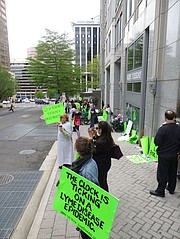Ozlem Jones has had Lyme disease for 11 years, but was only diagnosed two years ago when she began suffering from extreme bouts of fatigue and various problems with her nervous system. In that time, Jones says she passed it onto all three of her children. Antibiotic treatment led to a Herxheimer reaction, which left her unable to move without assistance and caused her to occasionally lose her vision. Jones sarcastically calls it the disease jackpot.
If you drove on Wilson Boulevard between N. Nash Street and N. Fort Meyer Drive on April 30 or May 1, there’s a good chance you may have seen Jones in her wheelchair on a sidewalk full of protesters dressed in neon green. Jones and dozens of others came to Arlington for a two-day protest against medical guidelines that say chronic Lyme disease is not a legitimate medical ailment.
The Mayday Project, an advocacy group arguing for medical recognition of chronic Lyme Disease, rallied in front of the Infectious Diseases Society of America (IDSA) headquarters in Arlington. The Mayday Project seeks changes in testing, medical guidelines, treatment access, physician training, and research funding.
According to Josh Cutler, a co-founder of The Mayday Project who contracted Lyme disease eight years ago, the protesters are demanding that IDSA guidelines accept that Lyme disease can persist after antibiotic treatment. Cutler accused doctors on the guidelines panel of conflicts of interest and accepting kickbacks from pharmaceutical companies.
IDSA released a statement on the protests, saying the organization is deeply sympathetic to the concerns of the Lyme disease community.
“At this time, IDSA is working together with the American Academy of Neurology (AAN) and the American College of Rheumatology (ACR) to develop new guidelines for Lyme disease,” said the IDSA. “The organizations hosted a 45-day public comment period seeking input regarding what should be included in the guideline, which will be considered as the guideline process moves forward. The organizations are committed to developing evidence-based recommendations gathered from the most current scientific research on the subject. Updated information on the status of the guideline will be provided on our website as it becomes available.”
In the organization’s statement, the IDSA said that until the guidelines change, it advises clinicians and patients to follow guidelines established in the 2006 “Clinical Assessment, Treatment, and Prevention of Lyme Disease, Human Granulocytic Anaplasmosis, and Babesiosis.” That document stated that there is “no convincing biological evidence for the existence of symptomatic chronic [Lyme disease] among patients after receipt of recommended treatment regimens for Lyme disease. Antibiotic therapy has not proven to be useful and is not recommended for patients with chronic (6 months) subjective symptoms after recommended treatment regimens for Lyme disease.”
According to a report by The Center for Disease Control (CDC), there are approximately 30,000 new cases of Lyme disease reported each year. The CDC’s guidelines for Post-Treatment Lyme Disease Syndrome say that symptoms of the disease may linger for up to six months after receiving antibiotic treatment, most likely from residual damage to muscles and the immune system. The CDC report also said that studies have not shown that patients who receive prolonged antibiotic treatment did not show improvement over those who received a placebo.
Some of the protesters adopted a more dramatic persona than others. Joe Murphy and Tiffany Sheets dressed up in black, white, and blue costumes, calling themselves Lyme Avenger and Lady Lyme. Murphy, who travelled to Arlington from Florida for the protest, was bitten by a tick when he was at a petting zoo. Murphy caught what he describes as a particularly antibiotic resistant strain of Lyme disease. Sheets said she’s had Lyme disease her whole life, a condition that was passed to her and her brothers from their mother. Sheets says since being diagnosed she has been constantly taking antibiotics and herbal remedies, but it’s done very little to help.
Alexandra Fleming is an Arlington resident whose daughter was diagnosed with Lyme disease when she was 19, but Fleming suspects her daughter had the disease long before then and it was not properly identified. Fleming said the disease has often been debilitating for her daughter, with fatigue and headaches keeping her out of sports and a diminished memory and concentration capacity hindering her school work.
“When you have a disease like cancer, you get all your treatment and your insurance is on board and the treatment is paid for, and that’s indisputable,” said Fleming. “With Lyme disease, if you see your tick and you present your symptoms, you’ll get a few weeks of treatment, but after that you’re on your own. Initially, when we found out she had it, the pediatrician said she’d only need a couple of weeks of antibiotics. She was on antibiotics for two years, with little progress, and now she’s on homeopathic therapy. These guidelines make it impossible for us to get treatment we need, for ourselves or our family members.”



